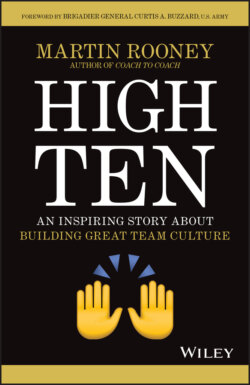Читать книгу High Ten - Martin Rooney - Страница 7
Foreword
ОглавлениеBottom line – great leaders focus on establishing great cultures! In High Ten, Martin Rooney tells an inspiring story about how to build a great team with a great culture, and he shares lessons and insights that will work anywhere: at home, in the military, on sports teams, or in corporate America. In the Army, our leaders are expected to provide purpose, direction, and motivation to their soldiers, and as commanders they are explicitly responsible for the culture of their units. But the very best commanders find a way for those in the unit to also “own” the culture – so it's everyone's responsibility. Martin drives this point home and then some.
Throughout my Army career, I've learned and observed that when building a culture, the foundation is character and values. These are essential to building trust, which leads to cohesive teams. Teams where people feel like they are part of something, not just in something. Teams that are loyal to one another and also to their values. Teams that are disciplined and whose standards exemplify excellence, and they hold one another accountable in meeting or exceeding those standards. Doing otherwise would be an acceptance of mediocrity, and that doesn't equate to winning on the battlefield, playing field, or in life. Strong cohesion also results in extraordinary resiliency, and teams that are able to absorb tough blows and bounce back even stronger. We all know what it's like to be on a great team with a great culture because it is enjoyable, rewarding, and they win. In High Ten, Martin reinforces all of these lessons and more through a story where two teams – one athletic and one business – grow from good to great by focusing on their culture.
While I was serving as the Commandant of Cadets at the United States Military Academy, our primary and enduring focus was on developing leaders of character. For any future leader, there's much to learn in this book, from appreciating why people are the centerpiece of your culture to ways to empower your people and reap the value of their initiative to understanding and leveraging the “3 Bs” of culture – Beings (who we are), Beliefs (what we stand for), and Behaviors (how we do it) – and, finally, to recognizing the indicators of good culture. Leaders will also learn the significance of “Culture Crusaders,” who perpetuate the culture, and to deeply examine their “Culture Custodians,” coveting the “Culture Keepers” and rooting out the “Culture Vultures.” As I read this book, I highlighted numerous passages, took notes, and reflected on my own efforts at creating cultures over the last 28 years of service. You can never stop studying leadership; it's a lifelong journey of education, experiences, and reflection.
Throughout High Ten, Martin also builds on his previous book, Coach to Coach, and reinforces that great leaders must also see themselves as coaches. He shares important insights on how to coach but also explains how a coach gets the whole team to steward the culture. It starts with the coach setting the foundation – the vision, standards, and expectations – and doing it alongside the players to maximize their ownership. Coaches then focus relentlessly on driving the team to achieve these goals. Martin also subtly reinforces that leadership and coaching are more art than science. The Xs and Os and tactics matter, but he reminds us that ultimately it's the culture that determines success. As Martin writes, “Your competitive advantage is culture.” If you want to learn to be a great coach and how to develop a great culture, then this book is for you!
Brigadier General Curtis A. Buzzard, U.S. Army
The views expressed in the foreword are those of the author and do not reflect the official position of the United States Military Academy, Department of the Army, or Department of Defense.
